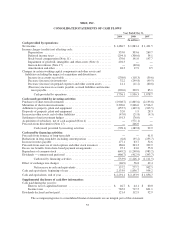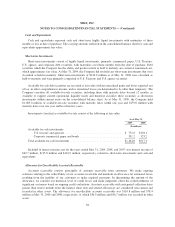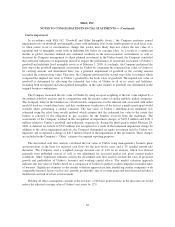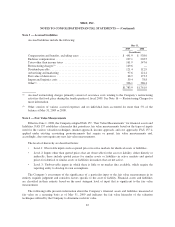Nike 2009 Annual Report Download - page 61
Download and view the complete annual report
Please find page 61 of the 2009 Nike annual report below. You can navigate through the pages in the report by either clicking on the pages listed below, or by using the keyword search tool below to find specific information within the annual report.NIKE, INC.
NOTES TO CONSOLIDATED FINANCIAL STATEMENTS — (Continued)
Inventory Valuation
Inventories related to our wholesale operations are stated at lower of cost or market and valued on a first-in,
first-out (“FIFO”) or moving average cost basis. Inventories related to our retail operations are stated at the lower
of average cost or market using the retail inventory method. Under the retail inventory method, the valuation of
inventories at cost is calculated by applying a cost-to-retail ratio to the retail value inventories. Permanent and
point of sale markdowns, when recorded, reduce both the retail and cost components of inventory on hand so as
to maintain the already established cost-to-retail relationship.
Property, Plant and Equipment and Depreciation
Property, plant and equipment are recorded at cost. Depreciation for financial reporting purposes is
determined on a straight-line basis for buildings and leasehold improvements over 2 to 40 years and for
machinery and equipment over 2 to 15 years. Computer software (including, in some cases, the cost of internal
labor) is depreciated on a straight-line basis over 3 to 10 years.
Impairment of Long-Lived Assets
The Company reviews the carrying value of long-lived assets or asset groups to be used in operations
whenever events or changes in circumstances indicate that the carrying amount of the assets might not be
recoverable. Factors that would necessitate an impairment assessment include a significant adverse change in the
extent or manner in which an asset is used, a significant adverse change in legal factors or the business climate
that could affect the value of the asset, or a significant decline in the observable market value of an asset, among
others. If such facts indicate a potential impairment, the Company would assess the recoverability of an asset
group by determining if the carrying value of the asset group exceeds the sum of the projected undiscounted cash
flows expected to result from the use and eventual disposition of the assets over the remaining economic life of
the primary asset in the asset group. If the recoverability test indicates that the carrying value of the asset group is
not recoverable, the Company will estimate the fair value of the asset group using appropriate valuation
methodologies which would typically include an estimate of discounted cash flows. Any impairment would be
measured as the difference between the asset groups carrying amount and its estimated fair value.
Identifiable Intangible Assets and Goodwill
In accordance with SFAS No. 142 “Goodwill and Other Intangible Assets” (“FAS 142”), the Company
performs annual impairment tests on goodwill and intangible assets with indefinite lives in the fourth quarter of
each fiscal year, or when events occur or circumstances change that would, more likely than not, reduce the fair
value of a reporting unit or an intangible asset with an indefinite life below its carrying value. Events or changes
in circumstances that may trigger interim impairment reviews include significant changes in business climate,
operating results, planned investments in the reporting unit, or an expectation that the carrying amount may not
be recoverable, among other factors. The impairment test requires the Company to estimate the fair value of its
reporting units. If the carrying value of a reporting unit exceeds its fair value, the goodwill of that reporting unit
is potentially impaired and the Company proceeds to step two of the impairment analysis. In step two of the
analysis, the Company measures and records an impairment loss equal to the excess of the carrying value of the
reporting unit’s goodwill over its implied fair value should such a circumstance arise.
The Company generally bases its measurement of fair value of a reporting unit on a blended analysis of the
present value of future discounted cash flows and the market valuation approach. The discounted cash flows
model indicates the fair value of the reporting unit based on the present value of the cash flows that the Company
expects the reporting unit to generate in the future. The Company’s significant estimates in the discounted cash
flows model include: its weighted average cost of capital; long-term rate of growth and profitability of the
59
























